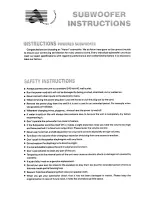
When power is applied to the UMS-1P,
there is a current inrush of approximate-
ly 12 Apk (at 115V) for approximately
20 milliseconds. Take this into account
when selecting the electrical service and
circuit breakers use dto power the UMS-
1P.
The UMS-1P presents a dynamic load to
the AC mains which causes the amount
of current to fluctuate between quiet
and loud operating levels. Since differ-
ent types of cables and circuit breakers
heat up and trip at varying rates, it is
essential to understand the types of cur-
rent ratings and how they correspond to
circuit breaker and cable specifications.
The
maximum continuous RMS current
is the maximum RMS current over a
duration of at least 10 seconds. It is
used to calculate the temperature
increase in cables, which is used to
select cables that conform to electrical
code standards. It is also used to select
the rating for slow-reacting thermal
breakers.
The
maximum burst RMS current
is the
maximum RMS current over a one sec-
ond duration. It is used to select the
rating for most magnetic breakers.
The
maximum instantaneous peak cur-
rent during burst
is used to select the
rating for fast-reacting magnetic break-
ers and to calculate the peak voltage
drop in long AC cables according to the
formula
V
pkdrop =
I
pk x
R
total cable
Use the table below as a guide to select
cables and circuit breakers with appro-
priate ratings for your operating volt-
age.
UMS-1P Current Ratings
To determine the minimum total service
power required by a system comprised
of UMS-1Ps and/or other Meyer Sound
self-powered loudspeaker systems, add
their maximum continuous RMS currents
together. We recommend allowing an
additional 30% above the minimum
amperage to prevent peak voltage drops
at the service entry and nuisance trip-
ping.
Looping
The internal electronics package of the
UMS-1P makes use of an unswitched,
direct connection. The blue connector
serves as the power input; to loop an
additional unit, simply attach a cable
from the grey connector of the first
loudspeaker system to the blue connec-
tor of the second, and so on.
Fuses
Always replace a fuse with one of the
same rating and type. The UMS-1P uses
a quick-acting 3.15A, 250V low breaking
capacity fuse. The same fuse is used for
all settings on the UPM-1P, i.e., the
3.15A fuse is used whether the product
is set for 100V, 115V, or 230V. If a fuse
should ever trip, contact your local
Meyer Sound Service Center or the
Service Department at the Meyer Sound
production facility.
Power Connector Wiring
Use the following AC cable wiring dia-
gram to create international or special-
purpose power connectors:
AC cable color code
If the colors referred to in the diagram
don't correspond to the terminals in
your plug, use the following guidelines:
• Connect the blue wire to the terminal
marked with an N or colored black.
• Connect the brown wire to the term-
inal marked with an L or colored red.
• Connect the green and yellow wire to
the terminal marked with an E or
or colored green or green and yellow.
Safety Issues
Do not use a ground-lifting adapter or
cut the AC cable ground pin.
Keep all liquids away from the UMS-1P
to avoid hazards from electrical shock.
Do not operate the unit with worn or
frayed cables; replace them immediately.
5
brown = hot
blue =
neutral
yellow/green =
earth ground
(chassis)
V
5
1
1
V
0
3
2
V
0
0
1
S
M
R
e
l
d
I
A
3
1
.
A
5
6
0
.
A
5
1
.
S
M
R
s
u
o
u
n
i
t
n
o
C
.
x
a
M
A
1
A
5
.
A
2
.
1
S
M
R
t
s
r
u
B
.
x
a
M
A
3
.
1
A
5
6
.
A
5
.
1
t
s
r
u
B
g
n
i
r
u
D
k
a
e
P
x
a
M
A
9
.
2
A
2
A
3
.
3
The rear panel of the UMS-1P has two
slots for processor modules. The top slot
contains the Audio Input and Control
Module; the bottom slot contains the
optional Remote Monitoring System™
(RMS) Module. A blank plate covers the
bottom slot if RMS is not installed.
Audio Input
There are two interchangeable Audio
Input and Control Modules with opti-
mized connectors and controls for differ-
ent applications.
Each module uses a three-pin, female
XLR audio input connector with a 10k
Ω
balanced input impedance wired with
the following convention:
Pin 1
-220 k
Ω
to chassis and earth
ground (ESD clamped)
Pin 2
-Signal
Pin 3
-Signal
Case
-Earth (AC) ground and chassis
Pins 2 and 3 carry the input as a differ-
ential signal. Use standard audio cables
with XLR connectors for balanced signal
sources. A single audio source can drive
multiple UMS-1Ps with a paralleled
input loop, creating an un buffered
hardwired loop connection, with negligi-
ble loss in signal level. For example,
since the input impedance of one UMS-
1P is 10k
Ω
, looping 10 UMS-1Ps pro-
duces a balanced input impedance of
1k
Ω
. With a 100
Ω
audio source, the
500
Ω
load results in only a .8 dB loss.
For drawings of the modules see page 11.
THE MODULAR REAR PANEL






























